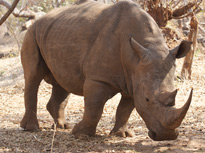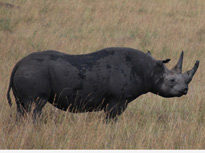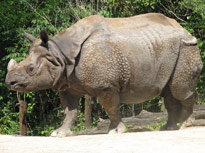Rhinocerotidae - Tanks with horns and a temper to boot!
Origins
The name "rhinoceros" translates directly from Greek as "nose-horn". All five species of rhino have at least one horn. This probably evolved as an adaptation for defense but it has become a huge liability because humans prize it for "medicinal" properties. Why do we always kill what we desire most? Quite vexing,really!
The family originated around 14 million years ago in the Miocene, and then further diverged into two horn and one horn species around 5 million years ago. Modern rhinoceroses are restricted to balmy climates, but several cold-adapted species once existed, including the woolly rhinoceros (Coelodonta) from the Pleistocene epoch.
What are they Like
A rhino's horn is made of compressed hair, not bone like cows. The horns have purported medicinal properties and are also used to make traditional ornaments -as a result, all rhinoceros species have been hunted to the brink of extinction. No wonder they are a bit short-tempered and likely to charge first and ask questions later. Assuming of course, that something does survive a 1,000 lb charging beast!
Their skin is tough and thick, falling into plate or armor-like folds; most species have little hair, but the Sumatran rhinoceros (Dicerorhinus sumatrensis) has long hair on the back and sides.
A comparison of different rhinoceros species is provided here courtesy of Wikipedia.
Geographic Distribution
Today, rhinos are found in eastern and southern Africa and southeast Asia. African rhinoceroses tend to inhabit more open terrain than the forest-dwelling Asian species. The Javan rhino (Rhinoceros sondaicus) is one of the most endangered species of mammals on earth today, with an estimated population of 60 individuals. The northern white rhino (Ceratotherium simum cottoni) is critically endangered with fewer than 30 wild individuals remaining.
Reproduction
Rhinos have relatively long pregnancies lasting as long as 16 months. A single calf is born and nurses until it is a year or so. Then it starts munching solely on vegetation with gusto. Rhino moms tend to have babies every couple of years or so.
Feeding Habits
White rhinos are excellent lawn mowers. It's a pity there are not more of them. They can graze up to 60 lbs of grass every single day. Black rhinos and their Asian cousins have a more varied diet, including fruit leaves and flowers.
Species within this family
Ceratotherium simum (White rhinoceros)
Dicerorhinus sumatrensis (Sumatran rhinoceros)
Diceros bicornis (Black rhinoceros)
Rhinoceros sondaicus (Javan rhinoceros)
Rhinoceros unicornis (Indian rhinoceros)
Videos



